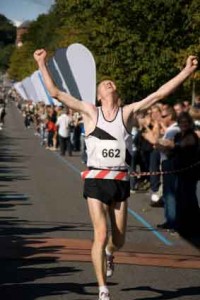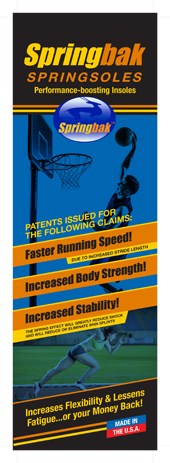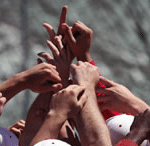Archive for Marathon/Triathlon Tips
Triathlon Training tips by Springbak: Making an Efficient Transition
Posted by: | Comments Most triathletes spend the bulk of their training time focused on the three events: swimming, cycling, and running. But the transition between each event also requires training. Each triathlon has two transitions: a swim-to-bike and a bike-to-run. Although they seem simple a poor transition can add precious time and waste energy during a race. A good transition can improve your position and spirits while a bad one can leave you struggling to make up lost time. Here are some tips to help you prefect your transitions.
Most triathletes spend the bulk of their training time focused on the three events: swimming, cycling, and running. But the transition between each event also requires training. Each triathlon has two transitions: a swim-to-bike and a bike-to-run. Although they seem simple a poor transition can add precious time and waste energy during a race. A good transition can improve your position and spirits while a bad one can leave you struggling to make up lost time. Here are some tips to help you prefect your transitions.
Simplify:
Keep your transitions clean and simple. By this, Springbak means don’t try to do too many things during a transition. Keep the number of tasks to the bare minimum. In a transition, the more you have to do, the more time it takes and the more that can go wrong. During the swim-to-bike transition, the fastest athletes may only put on a helmet and grab their bike to run out. Wear a one-piece racing suit to avoid clothing changes if possible. Some racers leave their shoes attached to the pedals and they put them on while riding. A trick they use is to rubber band the heel loops of the cycling shoes to the bike so that they are right side up. Sunglasses can be looped over the handlebars and put on down the road. Food and drink are already attached to the bike so you can fuel on the road as well.
Multi-task:
If you want to be efficient in the transition, you need to learn how to do a few things at once and keep moving in a seamless, fluid motion. Know what things you can do while running or riding or on the run-up to the transition zone and what you have to do before leaving. Something as small as taking off your cap and goggles, or unzipping your wetsuit on the run-up to the bike can save seconds, putting on your cap and sunglasses as you run is equally efficient. It may seem like these things take little or no time, but this will help keep your momentum for the next event.
Train for Transitions:
It is clear that if you want to get better at transitions, you need to practice them. But many athletes don’t practice this part of the race. A good time to practice is during your regular event training, but a mental walk-through of a transition is also important. Practicing transitions during your regular training will help you feel very comfortable on race days. This sort of practice is also a good time to try new techniques and to see what you can do without. Never try something new on race day.
Footwear Footwear: Springbak sponsors many of the top triathletes in the world. Triathletes use the Springbak Springsoles to get a competitive edge on their competition, as every second counts! Our performance insoles work by giving the runner a much longer stride length and quicker stride frequency. The average runner gains 4-6 inches per stride, so over the course of a marathon or triathlon, you have fewer strides, towards the end of a longer run you still feel fresh, and able to maintain a quick and efficient stride. To understand how Springbak accomplishes this, read our ‘patents’ page. Springbak Springsoles are used in the NFL, MLB, NHL, MLS, Olympic Teams and Top Division I Universities across the USA!
Race Day Set-up:
On race day, you should arrive with enough time to survey the transition area before the race and actually do your run-ups and exits so you know exactly where to go. Lay out your gear and do a test run to make sure everything is where you need it and ready to go. (This is very important) Make sure you can find your bike and know your path in and out. This pre-race check is also a good time to do a mental rehearsal as well. Visualizing your transition will help you deal with any challenges that are not a part of your practiced walk-through.
As you do more and more events, you will find what works best for you, but these tips will help you develop transitions that are efficient so you can save your energy for biking and running.
Sincerely,
Mark Vona – GM Springbak, Inc. ~ Hope you enjoy these training tips, all the best to you, please comment and add any of your personal triathlon tips that work for you as well. Happy running!






















